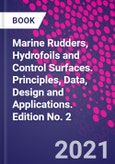The course keeping and manoeuvring requirements for a ship are governed by international maritime law. In assessing and predicting the course keeping and manoeuvring capabilities of the ship, knowledge is required of the rudder forces necessary to keep a course or facilitate a manoeuvre. The second edition of Marine Rudders, Hydrofoils and Control Surfaces includes up-to-date data and rudder design techniques that enable the rudder forces to be estimated, together with any interactions due to the hull and propeller. The new edition describes the design and application of hydrofoils including shape adaptive design, and their applications including hydrofoil craft, yachts, and kite surfing hydrofoils. The professional will also face the need to design control surfaces for motion control, such as roll and pitch, for surface vessels and submersibles, and the book contains the necessary techniques and data to carry out these tasks.
This book is for practicing naval architects and marine engineers, small craft designers, yacht designers, hydrodynamicists, undergraduate and postgraduate students of naval architecture, maritime engineering and ship science, and the broader engineering community involved in the development of marine craft that rely on the generation of 'lift' such as control engineers and aerodynamicists.
Please Note: This is an On Demand product, delivery may take up to 11 working days after payment has been received.
Table of Contents
1. Control surface types2. Physics of control surface operation
3. Control surface requirements
4. Experimental data
5. Theoretical and numerical methods
6. Detailed rudder design
7. Manoeuvring
8. Other control surfaces
9. Propulsion
10. Applications








